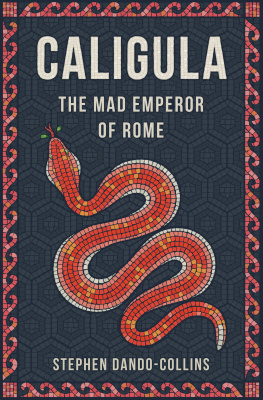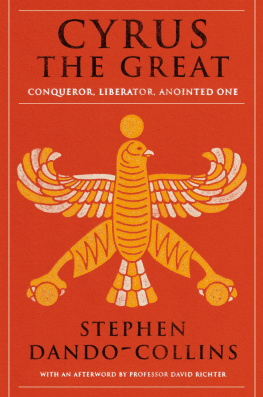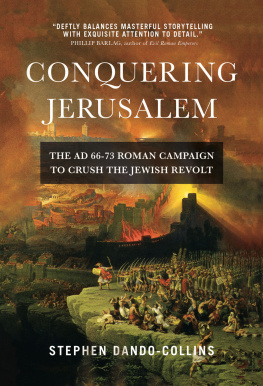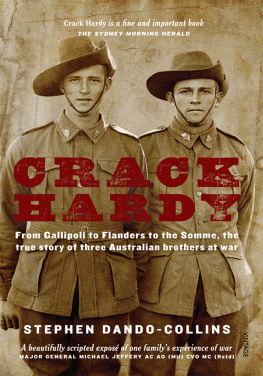Stephen Dando-Collins - Constantine at the Bridge
Here you can read online Stephen Dando-Collins - Constantine at the Bridge full text of the book (entire story) in english for free. Download pdf and epub, get meaning, cover and reviews about this ebook. year: 2021, publisher: Turner Publishing Company, genre: Non-fiction. Description of the work, (preface) as well as reviews are available. Best literature library LitArk.com created for fans of good reading and offers a wide selection of genres:
Romance novel
Science fiction
Adventure
Detective
Science
History
Home and family
Prose
Art
Politics
Computer
Non-fiction
Religion
Business
Children
Humor
Choose a favorite category and find really read worthwhile books. Enjoy immersion in the world of imagination, feel the emotions of the characters or learn something new for yourself, make an fascinating discovery.
- Book:Constantine at the Bridge
- Author:
- Publisher:Turner Publishing Company
- Genre:
- Year:2021
- Rating:3 / 5
- Favourites:Add to favourites
- Your mark:
- 60
- 1
- 2
- 3
- 4
- 5
Constantine at the Bridge: summary, description and annotation
We offer to read an annotation, description, summary or preface (depends on what the author of the book "Constantine at the Bridge" wrote himself). If you haven't found the necessary information about the book — write in the comments, we will try to find it.
Constantine at the Bridge — read online for free the complete book (whole text) full work
Below is the text of the book, divided by pages. System saving the place of the last page read, allows you to conveniently read the book "Constantine at the Bridge" online for free, without having to search again every time where you left off. Put a bookmark, and you can go to the page where you finished reading at any time.
Font size:
Interval:
Bookmark:
PRAISE FOR CONSTANTINE AT THE BRIDGE
A marvelous book. Constantine at the Bridge is an engaging and beautifully written study of a pivotal moment in Roman and European history. M ARK F ELTON , author of Castle of the Eagles: Escape from Mussolinis Colditz
Dando-Collinss writing in this book follows the maxims of good journalism He is an experienced and dependable writer. W ASHINGTON I NDEPENDENT R EVIEW OF B OOKS
Dando-Collinss skillful descriptions enable us to see not only how much but how little the world has changed. P ORTLAND B OOK R EVIEW
Highly readable, while retaining academic accuracy and serious addressing of facts and events Dando-Collins has a true gift as an author. H ISTORY AND H EADLINES
(A) fascinating historical study, thoroughly accessible to lay readers and scholars alike. Highly recommended. M IDWEST B OOK R EVIEW
CONSTANTINE AT THE BRIDGE
CONSTANTINE AT THE BRIDGE
HOW THE BATTLE OF THE MILVIAN BRIDGE CREATED CHRISTIAN ROME
STEPHEN DANDO-COLLINS

TURNER PUBLISHING COMPANY
Nashville, Tennessee
www.turnerpublishing.com
Copyright 2021 by Stephen Dando-Collins. All rights reserved.
Constantine at the Bridge
No part of this publication may be reproduced, stored in a retrieval system, or transmitted in any form or by any means, electronic, mechanical, photocopying, recording, scanning, or otherwise, except as permitted under Sections 107 or 108 of the 1976 United States Copyright Act, without either the prior written permission of the Publisher, or authorization through payment of the appropriate per-copy fee to the Copyright Clearance Center, 222 Rosewood Drive, Danvers, MA 01923, (978) 750-8400, fax (978) 750-4744. Requests to the Publisher for permission should be addressed to Turner Publishing Company, 4507 Charlotte Avenue, Suite 100, Nashville, Tennessee, (615) 255-2665, fax (615) 255-5081, e-mail: .
Cover design: Rebecca Lown
Book design: Erin Seaward-Hiatt
Maps design: Grace Cavalier
Library of Congress Control number: 2021021858
Names: Dando-Collins, Stephen, author. Title: Constantine at the bridge : how the Battle of the Milvian Bridge created Christian Rome / Stephen Dando-Collins. Other titles: How the Battle of the Milvian Bridge created Christian Rome Identifiers: LCCN 2021021858 (print) | LCCN 2021021859 (ebook) | ISBN 9781684426829 (paperback) | ISBN 9781684426836 (hardback) | ISBN 9781684426843 (ebook) Subjects: LCSH: Saxa Rubra, Battle of, Italy, 312. | Constantine I, Emperor of Rome, -337. | Maxentius, Marcus Aurelius Valerius, Emperor of Rome, -312. | Rome--History--Constantine I, the Great, 306-337. Classification: LCC DG315 .D36 2021 (print) | LCC DG315 (ebook) | DDC 937/.08--dc23 LC record available at https://lccn.loc.gov/2021021858 LC ebook record available at https://lccn.loc.gov/20210218599781684426829paperback
9781684426836hardback
9781684426843ebook
Printed in the United States of America
With thanks to my longtime New York literary agent and good friend, Richard Curtis, my publisher, Todd Bottorff, and editors Stephanie Beard and Ezra Fitz for their support and encouragement. And special thanks to my wife, Louise, who has been crossing bridges with me, hand in hand, for forty years .
TABLE OF CONTENTS
 Roman World, A.D. 312, showing domains of Constantine, Maxentius, Licinius, and Daia.
Roman World, A.D. 312, showing domains of Constantine, Maxentius, Licinius, and Daia.

 Bronze head of Constantine, discovered at Belgrade, believed to show him in later life. Bridgeman Images .
Bronze head of Constantine, discovered at Belgrade, believed to show him in later life. Bridgeman Images .
 The young emperor Maxentius, Constantines brother-in-law and opponent at the Battle of the Milvian Bridge, dressed in the regalia of the Pontifex Maximus. Bridgeman Images .
The young emperor Maxentius, Constantines brother-in-law and opponent at the Battle of the Milvian Bridge, dressed in the regalia of the Pontifex Maximus. Bridgeman Images .
 Surviving fragments from the Colossus of Constantine at Rome, including Constantines ten-foot-high head. Bridgeman Images .
Surviving fragments from the Colossus of Constantine at Rome, including Constantines ten-foot-high head. Bridgeman Images .
 Arch of Constantine, Rome Northern side. Bridgeman images .
Arch of Constantine, Rome Northern side. Bridgeman images .
 Detail from Arch of Constantine, depicting Constantine being driven in a massive open carriage from Verona, Italy, after conquering the city. Bridgeman Images .
Detail from Arch of Constantine, depicting Constantine being driven in a massive open carriage from Verona, Italy, after conquering the city. Bridgeman Images .
 A.D. 327 coin of Constantine depicting, on reverse, the Labarum stabbed into a serpent, issued to celebrate defeat of Licinius.
A.D. 327 coin of Constantine depicting, on reverse, the Labarum stabbed into a serpent, issued to celebrate defeat of Licinius.
I
THE EVE OF BATTLE
I N THE LAST WEEK OF OCTOBER IN THE YEAR A.D. 312, an army was marching on Rome from the north. On an autumn day, that army, of a little under 40,000 men, came down the Via Flaminia, the Flaminian Way, which linked Rome with the east coast Italian port city of Rimini and sliced through central Italy. Even though this was a Roman army, it was invading Italy, bent on conquering Rome.
Of the 8,000 cavalrymen in this force, not one was Italian. Some were Alemanni Germans, rough and ready Swabian mercenaries from east of the Rhine whose only allegiances were to profit and their tribal confederacy. Others were Romanized Germans, Gauls, Belgae, and Britons. Filling the infantry ranks were detachments from legions and auxiliary units, including archers normally stationed in Britain and at bases on the Upper and Lower Rhine. By this time, legionaries were recruited in the provinces where they were stationed, with the sons of retired legionaries the first choice when it came to recruits. Apart from some centurions, who transferred from legion to legion as they were promoted, none of these troops were Italian.
Here, in Italy, these invaders were foreigners in a foreign land, and as they tramped confidently along in marching order with helmets slung around their necks, baggage poles over their right shoulders, and wooden shields on their left, they chatted and bantered in Latin accented by their native dialects.
Look, Prima Porta! centurions of the advance guard would have called, as the arch of an elegant aqueduct running across the plain straddled the stone-paved highway in their path. That aqueduct served the old Villa of Livia, an imperial country house that sat on a hill beside the highway at Saxa Rubra, farther down the Via Flaminia. Centuries earlier, travelers had nicknamed this arch across the road Prima Porta, or First Door. For, to them, this was like the first door to Rome, which lay ten miles to the south.
Riding in a massive open carriage in the middle of the strung-out column of cavalrymen, foot soldiers, and a baggage train of thousands of heavily laden mules and carts was the armys thirty-five-year-old commander, Flavius Valerius Constantinus, a deputy emperor of Rome. We know him as Constantine. He was a tall, powerfully built man. Roman historian Zosimus, writing eighty years later, said that Constantines nickname was Bull Neck as a consequence of that build, and surviving busts show his thick neck and powerful shoulders. Zosimus also wrote that Constantine was only of average height, but all other sources, including several men who knew him, agreed that he was tall and often stood out in a crowd. Hook-nosed, with penetrating eyes and close-cropped but fussily tended hair, Constantine was clean-shaven, as was becoming the fashion among Roman men after beards had been de rigueur for two centuries. His prominent jaw was square and determined.
Next pageFont size:
Interval:
Bookmark:
Similar books «Constantine at the Bridge»
Look at similar books to Constantine at the Bridge. We have selected literature similar in name and meaning in the hope of providing readers with more options to find new, interesting, not yet read works.
Discussion, reviews of the book Constantine at the Bridge and just readers' own opinions. Leave your comments, write what you think about the work, its meaning or the main characters. Specify what exactly you liked and what you didn't like, and why you think so.








